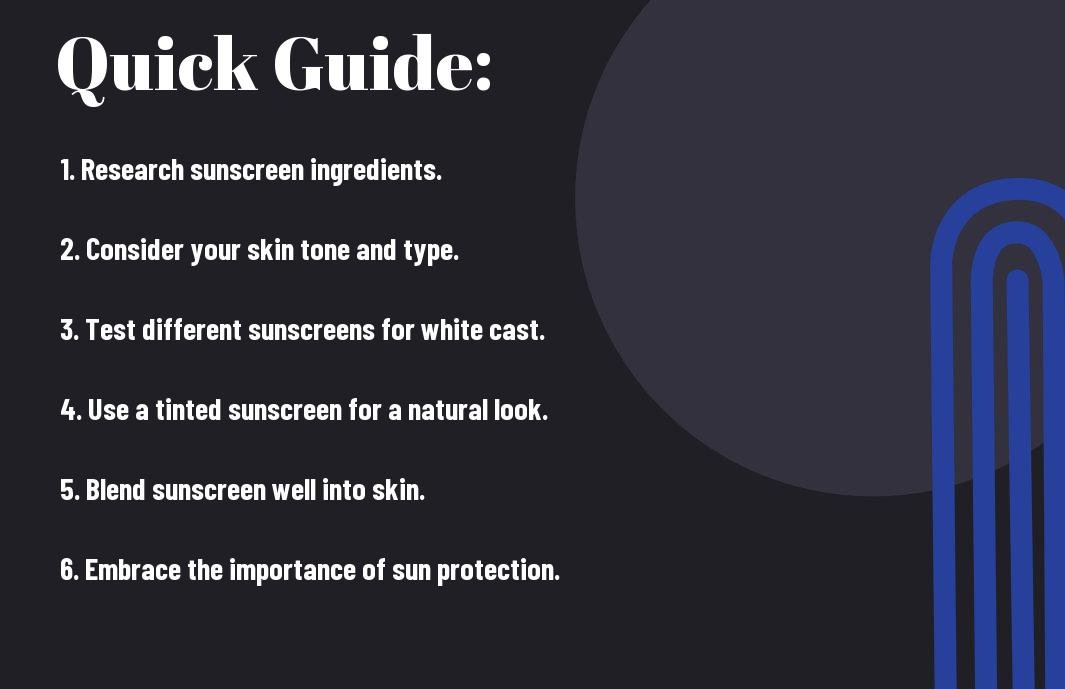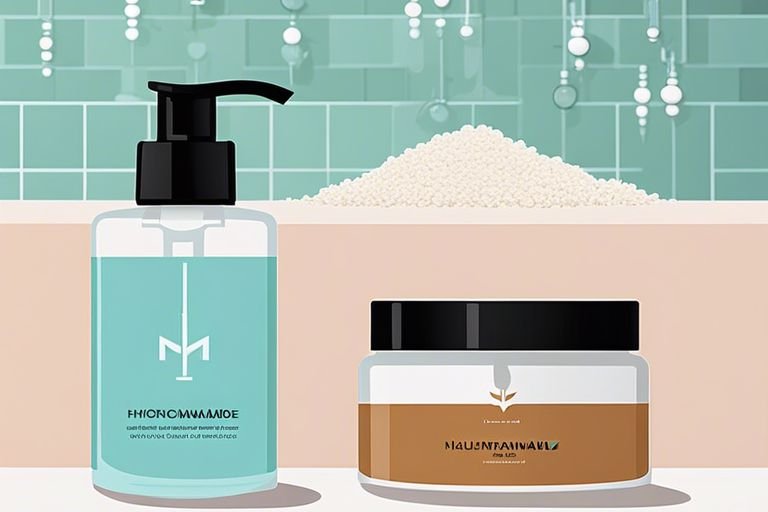As an avid sunscreen user, I have often come across the issue of white cast left behind by certain sunscreens. This led me to wonder if white cast sunscreen is actually bad for your skin, and if there are any negative effects associated with it. In this guide, I will delve into the aesthetics of sunscreen application, and discuss whether the white cast left behind by some sunscreens is harmful or not. I will also provide tips on how to choose a sunscreen that minimizes white cast, and highlight the importance of sunscreen in protecting your skin from dangerous UV rays. So, if you have ever wondered about the impact of white cast sunscreen on your skin, keep reading to find out more.
Key Takeaways:
- Mineral-based sunscreens containing white cast may provide better protection against UVA and UVB rays compared to chemical sunscreens.
- Proper application of white cast sunscreen can mitigate the visibility of the white residue, ensuring full coverage and protection.
- Using a tinted moisturizer or foundation on top of white cast sunscreen can help to blend the residue and provide a more aesthetically pleasing finish.
- Experimenting with different formulations and applications techniques can help individuals find a white cast sunscreen that works for their skin tone and personal preferences.
- The most important factor in sunscreen selection is its ability to effectively protect the skin from harmful UV rays, regardless of any potential white cast residue.
Types of Sunscreen
As I delve deeper into the world of sunscreen, I realize that there are primarily two types of sunscreen available in the market: physical sunscreens and chemical sunscreens. Each type works differently to protect your skin from the harmful effects of the sun. Let’s explore them in detail.
| Physical Sunscreens | Chemical Sunscreens |
| Provides immediate protection upon application | Takes about 20 minutes to start working |
| Sits on top of the skin and reflects UV rays | Gets absorbed into the skin and absorbs UV rays |
| Less likely to cause skin irritation | Potential for skin irritation, especially for sensitive skin |
| Effective for people with sensitive skin | May cause allergic reactions in some individuals |
| Can leave a white cast on the skin | Generally does not leave a white cast on the skin |
Physical Sunscreens
When it comes to physical sunscreens, I am a fan of their immediate protection upon application. They work by forming a protective barrier on the skin’s surface and deflecting UV rays away from the skin. This also means that they are less likely to cause irritation, making them a great option for those with sensitive skin.
Chemical Sunscreens
On the other hand, chemical sunscreens are known for their ability to get absorbed into the skin and absorb UV rays. This allows for a more lightweight and comfortable feel on the skin. However, it’s important to note that they may take about 20 minutes to start working, so it’s crucial to apply them before sun exposure.
Tips for Sunscreen Application
Obviously, applying sunscreen properly is crucial in protecting your skin from harmful UV rays. Here are some important tips to ensure effective and thorough application:
- Apply sunscreen at least 15 minutes before going outside to give it time to fully absorb into your skin.
- Be generous with the amount of sunscreen you apply. Most people do not use enough.
- Don’t forget commonly overlooked areas like the neck, ears, and tops of the feet.
- Reapply sunscreen every two hours, or more frequently if swimming or sweating.
- Utilize a lip balm with SPF to protect your lips as well.
The proper application of sunscreen is key to enjoying the sun while keeping your skin safe.
Proper Amount to Use
When it comes to applying sunscreen, the amount you use is crucial. I recommend applying at least a teaspoon-sized amount to your face and a shot glass-sized amount to cover your entire body. Underapplying sunscreen can significantly reduce its effectiveness in protecting your skin from harmful UV rays.
Reapplication
One of the most common mistakes people make is failing to reapply sunscreen regularly. I cannot stress enough how important it is to reapply every two hours, or more frequently if swimming or sweating. Even if your sunscreen claims to be water-resistant, it is essential to reapply to maintain adequate protection.
Best Practices for Application
In addition to applying the proper amount and reapplying regularly, there are a few best practices to keep in mind. I suggest using a broad-spectrum sunscreen with at least SPF 30 and applying it in front of a mirror to ensure no spots are missed. Additionally, make sure to rub the sunscreen in thoroughly to ensure even coverage. These practices will help you get the most out of your sunscreen and keep your skin well-protected.
Step-by-Step Guide to Sunscreen Application
Not sure if you are applying sunscreen the right way? Here’s a step-by-step guide to making sure you are protecting your skin from the harmful effects of the sun.
| Preparing the Skin | Applying Sunscreen |
| Before applying sunscreen, ensure that your skin is clean and dry. It’s important to exfoliate and moisturize the skin beforehand to ensure the sunscreen goes on evenly. | Start by applying sunscreen at least 15 minutes before going outside. Use about a shot glass worth of sunscreen for your entire body, and about a nickel-sized amount for your face. |
Preparing the Skin
Before heading out, it’s important to prepare your skin to ensure maximum sunscreen effectiveness. Exfoliating the skin and applying moisturizer beforehand can help the sunscreen go on more evenly and provide better protection against harmful UV rays.
Applying Sunscreen
When applying sunscreen, it’s essential to do so at least 15 minutes before sun exposure. This allows the sunscreen to fully bind to the skin and provide maximum protection. Use about a shot glass worth of sunscreen for your entire body and make sure to pay special attention to easily forgotten areas like the ears, back of the neck, and tops of the feet. As for your face, a nickel-sized amount is appropriate. Make sure to cover all exposed areas, including the ears and neck.
Additional Sun Protection Measures
In addition to applying sunscreen, there are other measures you can take to protect yourself from harmful UV rays. Wearing protective clothing, seeking shade during peak sun hours, and wearing a wide-brimmed hat are all effective ways to minimize sun exposure and protect your skin from damage.
Factors to Consider When Choosing Sunscreen
To ensure you are selecting the most appropriate sunscreen for your needs, there are several key factors to take into consideration. These include:
- Skin type
- Sun exposure
- Personal preferences
Each of these factors plays a crucial role in determining which sunscreen will offer you the best protection while also meeting your individual needs. The right sunscreen can make all the difference in safeguarding your skin from sun damage.
Skin Type
When it comes to choosing the right sunscreen, your skin type is a critical factor. If you have oily or acne-prone skin, you may want to opt for an oil-free, non-comedogenic sunscreen to prevent clogged pores. Those with sensitive skin should choose a sunscreen formulated for sensitive skin to avoid potential irritation. Individuals with dry skin may benefit from a sunscreen that offers added moisture. Understanding your skin type is essential in selecting a sunscreen that will provide adequate protection without causing adverse reactions.
Sun Exposure
The amount of sun exposure you anticipate is another vital consideration when choosing sunscreen. If you spend long hours outdoors or participate in outdoor activities, a broad-spectrum sunscreen with a high SPF is recommended to protect against prolonged sun exposure. On the other hand, if you have limited sun exposure due to being indoors most of the time, a lower SPF may be suitable for your daily needs. It’s important to assess your typical sun exposure to ensure your sunscreen offers the appropriate level of protection.
Personal Preferences
Your personal preferences also play a role in selecting sunscreen. Some people prefer a lightly scented sunscreen, while others may prefer a fragrance-free option. Texture and application method are also personal preferences to consider. Whether you prefer a lightweight, fast-absorbing lotion or a convenient spray sunscreen, choosing a product that aligns with your personal preferences can make regular sunscreen application more enjoyable. When you enjoy using your sunscreen, you’re more likely to apply it consistently, which is crucial for effective sun protection.
Pros and Cons of Using White Cast Sunscreen
After exploring the aesthetics of sunscreen application, it’s important to discuss the pros and cons of using white cast sunscreen. While it offers important protection against harmful UV rays, the visible residue left behind can be a concern for many individuals. Below, I’ve broken down the advantages and disadvantages of using white cast sunscreen in a clear and concise manner.
Advantages
When it comes to using white cast sunscreen, there are several advantages to consider. Firstly, white cast sunscreen provides high protection against both UVA and UVB rays, reducing the risk of sunburn, skin damage, and skin cancer. Additionally, the physical blockers in white cast sunscreen, such as zinc oxide and titanium dioxide, offer immediate protection upon application, making it an ideal choice for outdoor activities or prolonged sun exposure. White cast sunscreen also tends to be water-resistant, providing long-lasting protection, especially during activities that involve sweating or swimming.
Disadvantages
Despite its protective benefits, white cast sunscreen does have some downsides. One of the most noticeable drawbacks is the visible residue it leaves behind on the skin, which can give a chalky or pale appearance, especially on individuals with darker skin tones. This can be a major concern for those who prioritize the aesthetic aspect of their skincare routine. Additionally, some white cast sunscreens may have a thicker consistency compared to clear or tinted sunscreens, which can feel heavy or greasy on the skin and may require more effort to blend in properly.

Conclusion
Upon reflecting on the topic of whether white cast sunscreen is bad and exploring the aesthetics of sunscreen application, I have come to understand that the white cast effect of sunscreen is not inherently bad. It is a natural occurrence with some mineral sunscreens that provide excellent protection against harmful UV rays. While the white cast may be a concern for those with deeper skin tones, it is important to prioritize sun protection over aesthetics. Finding a sunscreen that works well with your skin type and color is key to ensuring that you are adequately protected from sun damage. Ultimately, the importance of sunscreen in preventing skin cancer and premature aging outweighs any aesthetic concerns, and it is crucial to make sunscreen application a regular part of your skincare routine. Thus, embracing the white cast as a sign of efficient protection is fundamental in maintaining healthy, protected skin.
FAQ
Q: Is white cast sunscreen bad for my skin?
A: White cast sunscreen is not necessarily bad for your skin. It is simply a result of the zinc oxide or titanium dioxide in the formula. These ingredients are effective at providing physical sun protection, but they can leave a white residue on the skin. However, this white cast does not have any negative impact on the health of your skin.
Q: How can I avoid the white cast when using sunscreen?
A: To avoid the white cast when using sunscreen, look for products that use micronized or nano-sized particles of zinc oxide and titanium dioxide. These smaller particles are less likely to leave a visible residue on the skin. Additionally, choosing a sunscreen with tinted or sheer formulations can help minimize the appearance of white cast.
Q: Can white cast sunscreen be effective at protecting my skin from the sun?
A: Yes, white cast sunscreen can be effective at protecting your skin from the sun. In fact, zinc oxide and titanium dioxide, which are responsible for the white cast, are excellent at providing broad-spectrum protection against both UVA and UVB rays. It is important to apply the sunscreen evenly and generously to ensure adequate coverage.
Q: Are there any drawbacks to using white cast sunscreen?
A: The main drawback of using white cast sunscreen is the aesthetic aspect. Some people may find the visible residue unappealing, especially on darker skin tones. However, advancements in sunscreen technology have led to the development of more cosmetically elegant formulations that minimize the white cast without sacrificing sun protection.
Q: How can I effectively remove white cast sunscreen from my skin?
A: To effectively remove white cast sunscreen from your skin, use a gentle cleanser and a soft cloth to ensure all residue is washed away. Double cleansing can also be beneficial, using an oil-based cleanser followed by a water-based cleanser to thoroughly remove any sunscreen build-up. Exfoliating regularly can also help prevent any potential build-up of zinc oxide or titanium dioxide.












